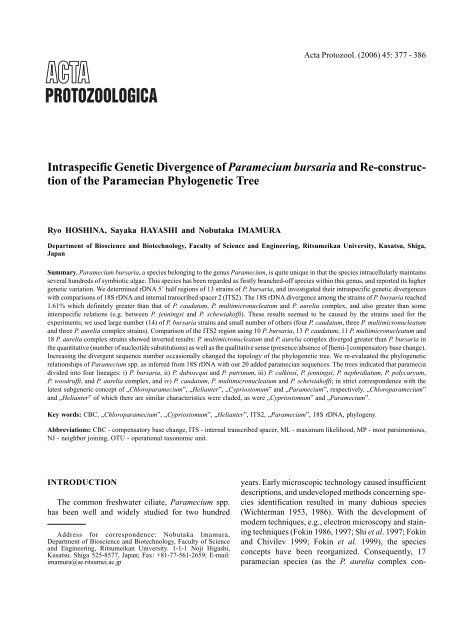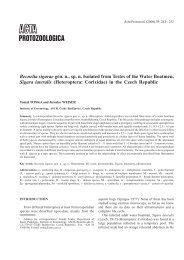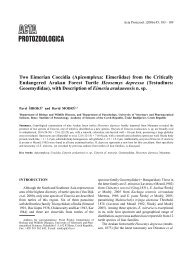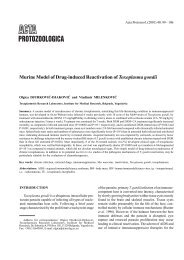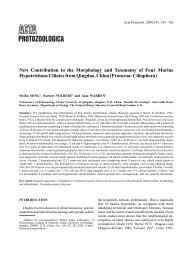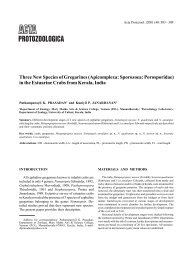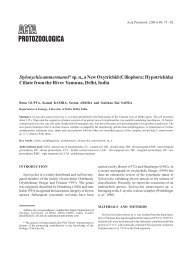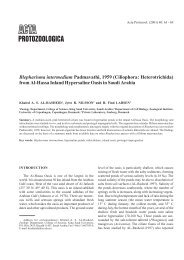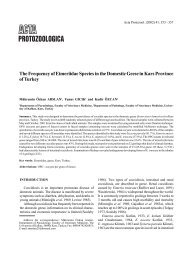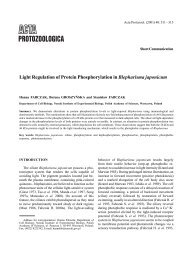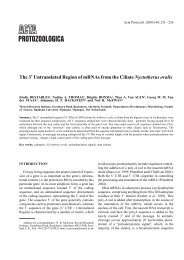Intraspecific Genetic Divergence of Paramecium ... - CiteSeerX
Intraspecific Genetic Divergence of Paramecium ... - CiteSeerX
Intraspecific Genetic Divergence of Paramecium ... - CiteSeerX
Create successful ePaper yourself
Turn your PDF publications into a flip-book with our unique Google optimized e-Paper software.
Acta Protozool. (2006) 45: 377 - 386<br />
<strong>Intraspecific</strong> <strong>Genetic</strong> <strong>Divergence</strong> <strong>of</strong> <strong>Paramecium</strong> bursaria and Re-construction<br />
<strong>of</strong> the Paramecian Phylogenetic Tree<br />
Ryo HOSHINA, Sayaka HAYASHI and Nobutaka IMAMURA<br />
Department <strong>of</strong> Bioscience and Biotechnology, Faculty <strong>of</strong> Science and Engineering, Ritsumeikan University, Kusatsu, Shiga,<br />
Japan<br />
Summary. <strong>Paramecium</strong> bursaria, a species belonging to the genus <strong>Paramecium</strong>, is quite unique in that the species intracellularly maintains<br />
several hundreds <strong>of</strong> symbiotic algae. This species has been regarded as firstly branched-<strong>of</strong>f species within this genus, and reported its higher<br />
genetic variation. We determined rDNA 5’ half regions <strong>of</strong> 13 strains <strong>of</strong> P. bursaria, and investigated their intraspecific genetic divergences<br />
with comparisons <strong>of</strong> 18S rDNA and internal transcribed spacer 2 (ITS2). The 18S rDNA divergence among the strains <strong>of</strong> P. bursaria reached<br />
1.61% which definitely greater than that <strong>of</strong> P. caudatum, P. multimicronucleatum and P. aurelia complex, and also greater than some<br />
interspecific relations (e.g. between P. jenningsi and P. schewiak<strong>of</strong>fi). These results seemed to be caused by the strains used for the<br />
experiments; we used large number (14) <strong>of</strong> P. bursaria strains and small number <strong>of</strong> others (four P. caudatum, three P. multimicronucleatum<br />
and three P. aurelia complex strains). Comparison <strong>of</strong> the ITS2 region using 10 P. bursaria, 13 P. caudatum, 11 P. multimicronucleatum and<br />
18 P. aurelia complex strains showed inverted results: P. multimicronucleatum and P. aurelia complex diverged greater than P. bursaria in<br />
the quantitative (number <strong>of</strong> nucleotide substitutions) as well as the qualitative sense (presence/absence <strong>of</strong> [hemi-] compensatory base change).<br />
Increasing the divergent sequence number occasionally changed the topology <strong>of</strong> the phylogenetic tree. We re-evaluated the phylogenetic<br />
relationships <strong>of</strong> <strong>Paramecium</strong> spp. as inferred from 18S rDNA with our 20 added paramecian sequences. The trees indicated that paramecia<br />
divided into four lineages: i) P. bursaria, ii) P. duboscqui and P. putrinum, iii) P. calkinsi, P. jenningsi, P. nephridiatum, P. polycaryum,<br />
P. woodruffi, and P. aurelia complex, and iv) P. caudatum, P. multimicronucleatum and P. schewiak<strong>of</strong>fi; in strict correspondence with the<br />
latest subgeneric concept <strong>of</strong> „Chloroparamecium”, „Helianter”, „Cypriostomum” and „<strong>Paramecium</strong>”, respectively. „Chloroparamecium”<br />
and „Helianter” <strong>of</strong> which there are similar characteristics were claded, as were „Cypriostomum” and „<strong>Paramecium</strong>”.<br />
Key words: CBC, „Chloroparamecium”, „Cypriostomum”, „Helianter”, ITS2, „<strong>Paramecium</strong>”, 18S rDNA, phylogeny.<br />
Abbreviations: CBC - compensatory base change, ITS - internal transcribed spacer, ML - maximum likelihood, MP - most parsimonious,<br />
NJ - neighbor joining, OTU - operational taxonomic unit.<br />
INTRODUCTION<br />
The common freshwater ciliate, <strong>Paramecium</strong> spp.<br />
has been well and widely studied for two hundred<br />
Address for correspondence: Nobutaka Imamura,<br />
Department <strong>of</strong> Bioscience and Biotechnology, Faculty <strong>of</strong> Science<br />
and Engineering, Ritsumeikan University. 1-1-1 Noji Higashi,<br />
Kusatsu, Shiga 525-8577, Japan; Fax: +81-77-561-2659; E-mail:<br />
imamura@se.ritsumei.ac.jp<br />
years. Early microscopic technology caused insufficient<br />
descriptions, and undeveloped methods concerning species<br />
identification resulted in many dubious species<br />
(Wichterman 1953, 1986). With the development <strong>of</strong><br />
modern techniques, e.g., electron microscopy and staining<br />
techniques (Fokin 1986, 1997; Shi et al. 1997; Fokin<br />
and Chivilev 1999; Fokin et al. 1999), the species<br />
concepts have been reorganized. Consequently, 17<br />
paramecian species (as the P. aurelia complex con-
378 R. Hoshina et al.<br />
verted into one species) are now recognized as valid<br />
(Fokin et al. 2004).<br />
Among <strong>Paramecium</strong> spp., morphology and other<br />
characteristics are diverse, which have brought subgeneric<br />
concepts into this genus (Woodruff 1921; Jankowski<br />
1969, 1972). The latest concept based upon morphometric,<br />
biological and molecular differences divides<br />
the above 17 species into four subgenera:<br />
„Chloroparamecium”, „Helianter”, „Cypriostomum”<br />
and „<strong>Paramecium</strong>” (Fokin et al. 2004).<br />
„Chloroparamecium” is composed <strong>of</strong> only one species<br />
P. bursaria, and prior studies (Strüder-Kypke et al.<br />
2000a, b; Fokin et al. 2004) have suggested this species<br />
diverged first in the genus <strong>Paramecium</strong>.<br />
If P. bursaria is regarded as an “old species”, the<br />
intraspecific genetic divergence is possibly larger. In<br />
fact, Stoeck et al. (1998) reported higher genetic diversities<br />
than in other paramecian species. The highest 18S<br />
rDNA pairwise distance seen in P. bursaria reached<br />
1.57% (gaps were included, Hoshina et al. 2005); e.g.<br />
the recently described species P. schewiak<strong>of</strong>fi (Fokin et<br />
al. 2004; GenBank accession no., AJ548821) differed by<br />
0.73% from P. jenningsi (AF100311) and by 1.11%<br />
from P. tetraurelia (X03772).<br />
The sibling species concept seen in <strong>Paramecium</strong> spp.<br />
has been investigated with various methods e.g. with<br />
isozymes (Allen and Gibson 1971) and random amplified<br />
polymorphic DNA (RAPD, Stoeck et al. 1998, 2000;<br />
Stoeck and Schmidt 1998). However, it is problematic to<br />
consider their phylogeny or distance. Coleman (2000,<br />
2005) proposed the utility <strong>of</strong> internal transcribed spacer<br />
2 (ITS2) sequence comparison for such species or nonspecies<br />
affair. Although this region is a non gene-coding<br />
region, it might be limited to primary and secondary<br />
sequence variation in the potential gene exchange group.<br />
She also showed the applicability <strong>of</strong> this region for<br />
paramecian species, and indicated the linkage between<br />
sequence variation and gene exchange. Although the<br />
precise cause <strong>of</strong> above genetic distances in P. bursaria<br />
are as yet not well known, in this study we compared<br />
their ITS2 sequences as well as the 18S rDNA sequences.<br />
We have collected P. bursaria strains from studies<br />
relating their symbionts (Hoshina et al. 2004, 2005) and<br />
the other comparative paramecian stocks, and have used<br />
18S rDNA sequence comparison. As a result, we obtained<br />
20 operational taxonomic units (OTUs) <strong>of</strong> 18S<br />
rDNA sequences from <strong>Paramecium</strong> spp. (Hoshina et<br />
al. 2005 and this study), which more than doubles the<br />
number <strong>of</strong> available sequences compared to other phylogenetic<br />
assessments based on this sequence (Fokin et<br />
al. 2004). It is well known that increases in the numbers<br />
<strong>of</strong> sequences frequently changes the phylogenetic tree<br />
topology (e.g. Graur and Li 2000, Nei and Kumar 2000).<br />
Consequently, we attempted to re-construct the<br />
paramecian phylogenetic tree.<br />
MATERIALS AND METHODS<br />
<strong>Paramecium</strong> bursaria, P. caudatum, P. multimicronucleatum and<br />
P. tetraurelia stocks (Table 1) were maintained in aka-endoumame<br />
medium (Tsukii et al. 1995) or in accordance with CCAP (Culture<br />
Collection <strong>of</strong> algae and Protozoa, UK) instructions, at 25°C with cool<br />
white light illumination (16 L: 8 D, 100 µmol photons m -2 s -1 ).<br />
For DNA extraction, we used the modified CTAB method (outlined<br />
in Hoshina et al. 2004), or the DNeasy plant mini kit (Qiagen,<br />
GmbH, Düsseldorf, Germany) according to manufacturer’s directions.<br />
A part <strong>of</strong> the total DNA used for the following analyses were<br />
those obtained by Hoshina et al. (2005).<br />
DNA amplification and sequencing primers for ribosomal DNAs<br />
are described in Hoshina et al. (2005). For ITS amplification, we used<br />
the alternative primer sets <strong>of</strong> <strong>Paramecium</strong>500F (Hoshina et al.<br />
2005)/ITS4 (White et al. 1990) or <strong>Paramecium</strong>730F<br />
(5’-GTGTTTCAGGCAGGTTTTCG-3’, forward direction)/ITS4.<br />
The PCR products were once sequenced directly. Low-quality<br />
electrophorograms were observed in the sequences <strong>of</strong> ITS regions <strong>of</strong><br />
P. bursaria CCAP 1660/12 and 1660/13, which were cloned using the<br />
TArget Clone kit (Toyobo, Osaka, Japan) according to manufacturer’s<br />
recommended protocols.<br />
We compared all available (published by Strüder-Kypke et al.<br />
2000a, b; Coleman 2005; Barth et al. 2006) and our (Table 1) sequences<br />
<strong>of</strong> P. bursaria, P. caudatum, P. multimicronucleatum and<br />
P. aurelia complex. 18S rDNA sequences (14 strains <strong>of</strong> P. bursaria,<br />
four P. caudatum, three P. multimicronucleatum and three P. aurelia<br />
complex) were manually aligned using Clustal X version 1.81<br />
(Thompson et al. 1997). For ITS2 comparison, once we made secondary<br />
structural models for every sample, these were referred to<br />
that <strong>of</strong> P. tetraurelia (Coleman 2005; a brief diagram is shown in<br />
Fig. 1). Helix constructions were predicted by mfold version 3.2<br />
(Zuker 2003) and ITS2 sequences (10 P. bursaria, 13 P. caudatum, 11<br />
P. multimicronucleatum and 18 P. aurelia complex) were aligned by<br />
considering the above secondary structure. Unrooted distance trees<br />
based on each 18S rDNA and ITS2 were constructed (Fig. 2) by<br />
Neighbor Joining (uncorrected “p” distance) in PAUP version 4.0b10<br />
(Sw<strong>of</strong>ford 2000).<br />
For the re-construction <strong>of</strong> the paramecian phylogenetic tree, we<br />
employed all available paramecian sequences (published by Strüder-<br />
Kypke et al. 2000a, b; Fokin et al. 2004) with 15 other ciliates (see<br />
Fig. 3). Once we aligned them using Clustal X, they were compared to<br />
available 18S rRNA structures (Comparative RNA Web Site, Cannone<br />
et al. 2002), manually adjusted, and ambiguous regions lying at<br />
hairpin loops, internal loops or bulges were removed. Phylogenetic<br />
trees based on this 18S rDNA dataset were constructed using PAUP.<br />
For maximum likelihood (ML) analyses, optimal likelihood settings<br />
for evolutionary models were determined by Modeltest version 3.6<br />
(Posada and Crandall 1998), which resulted in a model and respective
<strong>Intraspecific</strong> genetic divergence <strong>of</strong> <strong>Paramecium</strong> 379<br />
parameters or proportions for each dataset. With those settings, a<br />
heuristic search was performed (nearest-neighbor interchange algorithm,<br />
starting tree obtained via neighbor joining). Maximum parsimony<br />
(MP) analysis was performed using a heuristic search with the<br />
bisection-reconnection option and random sequence addition with 10<br />
replications; gaps were treated as a fifth base. Neighbor Joining (NJ)<br />
analysis <strong>of</strong> Saito and Nei was also performed. The bootstrap probabilities<br />
were calculated by all ML (100 replicates), MP (1000) and<br />
NJ (1000) analyses.<br />
whole genome analysis. Indeed, recent intraspecific<br />
studies <strong>of</strong> paramecia using rDNA cistron also chose<br />
RESULTS<br />
Sequences and genetic intraspecies diversity <strong>of</strong><br />
P. bursaria<br />
The variation seen in multiple copies <strong>of</strong> a single locus<br />
has been reported in a paramecium (Preer et al. 1999).<br />
However, most <strong>of</strong> our electrophorograms from direct<br />
sequencing showed definite single peaks. If different<br />
sequences were present, their copy number in the<br />
genome seems proportionately below our detection level.<br />
It probably needs tens or hundreds <strong>of</strong> subcloning procedure<br />
to detect such minor variation, and truthfully, the<br />
quest for all minor variation is never ending without<br />
Fig. 1. Secondary structural diagram <strong>of</strong> paramecian ITS2 modified<br />
from Coleman, 2005. ITS2 usually forms a four-fingered hand structure<br />
in eukaryotic organisms (Coleman 2003); helices I and IV occasionally<br />
evolve rapidly, and in paramecia, these are absent (see<br />
Coleman 2005).<br />
Table 1. Paramecian strains <strong>of</strong> which DNA sequence were obtained in this study.<br />
Strains syngen/mating Collection site Accession<br />
18S rDNA<br />
ITS<br />
P. bursaria OK1 1/I Aich, Japan AB206537 a AB252010<br />
P. bursaria So13 1/I Nagano, Japan AB206538 a AB252011<br />
P. bursaria F36 1/II<br />
b<br />
AB206539 a AB252012<br />
P. bursaria KM2 1/I Shimane, Japan AB206540 a<br />
P. bursaria Dd1 1/II Ibaraki, Japan AB206541 a<br />
P. bursaria Bnd1 1/III Hiroshima, Japan AB206542 a<br />
P. bursaria Cs2 1/II Shanghai, China AB206543 a AB252013<br />
P. bursaria MRBG1 Melbourne, Australia AB219526 a AB252014<br />
P. bursaria PB-SW1 Schwarzwald, Germany AB206544 a AB252015<br />
P. bursaria CCAP1660/10 2/V AB252000 AB252016<br />
P. bursaria CCAP1660/11 2 Cambridge, UK AB206545 a AB252017<br />
P. bursaria CCAP1660/12 Cambridge, UK AB252001 AB252018-24<br />
P. bursaria CCAP1660/13 Cambridge, UK AB252002 AB252025-38<br />
P. caudatum Isn4 12/XXIII Iwate, Japan AB252003 AB252039<br />
P. caudatum KNZ2 3/VI Kanazawa, Japan AB252004 AB252040<br />
P. caudatum Yhm Yamaguchi, Japan AB252005 AB252041<br />
P. multimicronucleatum TH105 2/IV AB252006 AB252042<br />
P. multimicronucleatum YM25 cycler c Ishinomaki, Japan AB252007 AB252043<br />
P. tetraurelia 51 4/VII USA AB252008 AB252044<br />
P. tetraurelia hrd 4/VIII AB252009 AB252045<br />
a<br />
Accessions obtained in Hoshina et al. (2005); b One <strong>of</strong> F1 crossbreed between T151 (1/IV, Ibaraki, Japan) and Mts4 (1/I, Nagano, Japan);<br />
c<br />
Janiform entity <strong>of</strong> 2/III and 2/IV, see Barnett (1966).
380 R. Hoshina et al.<br />
Fig. 2. Unrooted phylograms showing genetic divergences among <strong>Paramecium</strong> bursaria, P. caudatum, P. multimicronucleatum and P. aurelia<br />
complex: a, based on 18S rDNA; b, based on 163 aligned nucleotides (gaps included) <strong>of</strong> ITS2.<br />
direct sequencing method (Coleman 2005, Barth et<br />
al. 2006). Thus, we quit subsequent clonings for the<br />
PCR products <strong>of</strong> which electrophorograms have undoubted<br />
peaks. The visible double peaks or dubious<br />
electrophorograms were seen only in spacer regions <strong>of</strong><br />
two strains <strong>of</strong> P. bursaria, which were defined by a<br />
subcloning method. Seven clones detected a single nucleotide<br />
polymorphism (SNP, C/T mixtures) and 19 nucleotide<br />
insertion/deletions in ITS1 <strong>of</strong> CCAP 1660/12; and<br />
in 14 clones a C/T variation was detected in the 5.8S<br />
rDNA and two C/T and two A/G variations in the ITS2<br />
region <strong>of</strong> CCAP 1660/13. The positions <strong>of</strong> SNPs corresponded<br />
to those <strong>of</strong> the double peaks seen when sequenced<br />
directly.<br />
Four types <strong>of</strong> 18S rDNA sequences were found in<br />
P. bursaria (Fig. 4a): A) CCAP 1660/12 and 1660/13;<br />
B) 1660/10 and a Canadian strain (Strüder-Kypke et al.<br />
2000a, AF100314); C) PB-SW1 and 1660/11; D) OK1,<br />
So13, F36, KM2, Dd1, Bnd1, Cs2, MRBG1. The intraspecific<br />
distance reached 23 substitutions + 4 insertion/deletions<br />
between genetic group <strong>of</strong> C and D. Oppositely,<br />
there were only two transitions between A and B.<br />
The unrooted 18S rDNA tree (Fig. 2a) revealed big<br />
intraspecific distances <strong>of</strong> <strong>Paramecium</strong> bursaria compared<br />
to the other three species; five substitutions were<br />
seen in P. multimicronucleatum and in P. aurelia complex,<br />
and no divergence in P. caudatum.<br />
Six different ITS2 sequences were recognized when<br />
14 clones <strong>of</strong> CCAP 1660/13 were regarded as independent<br />
OTUs (Fig. 4b): i) CCAP 1660/10, 1660/11, 1660/<br />
12 and 1660/13 clones 01-03, 05-07 and 11-14; ii) PB-<br />
SW1 and CCAP 1660/13 clone 08; iii) CCAP 1660/13<br />
clone 04; iv) CCAP 1660/13 clone 09; v) CCAP 1660/<br />
13 clone 10; vi) OK1, So13, F36, Cs2 and MRBG1.<br />
There were only one or two transitions among the<br />
genetic groups i through v, and the group vi differed two<br />
or more nucleotides + one insertion/deletions from the<br />
others. The ITS2 tree (Fig. 2b) showed the reverse<br />
result to that <strong>of</strong> the 18S rDNA. Up to 6 substitutions<br />
were seen both in P. multimicronucleatum and in<br />
P. aurelia complex, yet 3 substitutions + 1 insertion/<br />
deletion was found among P. bursaria strains as a<br />
maximum (group i vs. groups iii-vi). No divergence was<br />
seen in P. caudatum.<br />
Depending on species (-complex), there were several<br />
varieties such as helix length and bulges, although the<br />
general structure <strong>of</strong> ITS2 was common to all four<br />
species. For intraspecific comparison, while most <strong>of</strong> the
<strong>Intraspecific</strong> genetic divergence <strong>of</strong> <strong>Paramecium</strong> 381<br />
Fig. 3. Phylogenetic tree <strong>of</strong> paramecia constructed from an analysis <strong>of</strong> 18S rRNA gene sequences. Tree topology was obtained by ML analysis.<br />
Numerals at each nodes are bootstrap probabilities <strong>of</strong> ML (100 replicates) / MP (1000 replicates) / NJ (1000 replicates) analyses; only values<br />
above 50% support are shown.<br />
nucleotide substitutions or insertion/deletions were seen<br />
at single loops (including bulges), two compensatory<br />
nucleotide substitutions without structural changes were<br />
also seen. One was hemi-CBC (compensatory change<br />
on only one side <strong>of</strong> a helix pairing: U-A/U-G) at helix III<br />
(Fig. 1) in P. aurelia complex, which was reported by<br />
Coleman (2005). The other was CBC (compensatory<br />
base change: U-A/C-G) found at the tip <strong>of</strong> helix II (Fig.<br />
1) <strong>of</strong> P. multimicronucleatum. Neither CBC nor hemi-<br />
CBC was found in species <strong>of</strong> P. bursaria.<br />
Paramecian phylogeny<br />
Phylogenetic analyses <strong>of</strong> the 34 paramecian 18S<br />
rDNA sequences were performed with 15 other ciliates.<br />
Once we tried multiple alignment with the out group taxa<br />
as employed by Strüder-Kypke et al. (2000b). Although<br />
they instructed on gap-handlings for length polymorphic<br />
region Helix E10_1 among them, such length polymorphic<br />
regions were abundant when compared to<br />
the outermost spirotrich taxa. We therefore employed
382 R. Hoshina et al.<br />
Fig. 4. Variable positions <strong>of</strong> the DNA sequences from P. bursaria.<br />
Differences from the uppermost variant are shown by nucleotide,<br />
identical nucleotides by a dot, and a dash denotes a missing nucleotide:<br />
a, 18S rDNA sequence comparison. Numbers are nucleotide<br />
positions based on aligned P. bursaria sequences (1684 positions)<br />
with the exception <strong>of</strong> 5’ primer binding region. Variants include the<br />
following strains. Variant A: CCAP 1660/12 and 1660/13, B: 1660/10<br />
and Canadian P. bursaria (AF100314), C: 1660/11 and PB-SW1,<br />
D: OK1, So13, F36, KM2, Dd1, Bnd1, Cs2, MRBG1; b, ITS2<br />
sequence comparison. 181 aligned positions were compared. Variants<br />
include the following strains. Variant i: CCAP 1660/10, 1660/11,<br />
1660/12, ii: PB-SW1, iv: OK1, So13, F36, Cs2 and MRBG1, and<br />
1660/13 clones expand to i through v.<br />
the much closer OTU (Trithigmostoma steini,<br />
Phyllopharyngea) as the outermost taxon. Careful alignment<br />
with consideration <strong>of</strong> available 18S rRNA secondary<br />
structure models resulted in a1587 base data set<br />
(including small gaps).<br />
The likelihood score (-ln L = 11438.34706)<br />
was obtained under the GTR + G + I model with the<br />
following parameters: assumed nucleotide frequencies<br />
A = 0.280583, C = 0.191251, G = 0.255734, and<br />
T = 0.272432; substitution-rate matrix with<br />
AC = 1.0310318, AG = 2.44942, AT = 1.6560309,<br />
CG = 0.71779526, CT = 4.2100064, and GT = 1; the<br />
proportion <strong>of</strong> sites assumed to be invariable = 0.355723;<br />
rates for variable sites assumed to follow a gamma<br />
distribution with shape parameter = 0.443514. With<br />
these settings, the heuristic search was performed<br />
(Fig. 3). The ML tree indicated that the genus paramecium<br />
makes a monophyletic (100% bootstrap support)<br />
clade which has a sister relationship with Frontonia<br />
spp., and formed a robust clade with Lembadion<br />
bullinum. Members <strong>of</strong> the paramecia were divided into<br />
two large clades, the P. bursaria, P. duboscqui and<br />
P. putrinum clade (77%), and the P. calkinsi,<br />
P. polycaryum, P. nephridiatum, P. woodruffi,<br />
P. jenningsi, P. aurelia complex (-aurelia in Fig. 3),<br />
P. schewiak<strong>of</strong>fi, P. multimicronucleatum and<br />
P. caudatum clade (76%). The former large clade was<br />
further divided into the P. bursaria clade and the<br />
P. duboscqui-P. putrinum clade from a topological<br />
perspective; the P. bursaria clade was supported by<br />
100% bootstraps, yet, the P. duboscqui-P. putrinum<br />
clade was supported below 50%. The latter large clade<br />
was also divided into two, the P. calkinsi, P. polycaryum,<br />
P. nephridiatum, P. woodruffi clade and the<br />
P. jenningsi, P. aurelia complex, P. schewiak<strong>of</strong>fi,<br />
P. multimicronucleatum, P. caudatum clade; both were<br />
moderately to highly supported (69% and 95%).<br />
The six most parsimonious trees were obtained in<br />
2230 steps (trees were not shown; number <strong>of</strong> parsimony-informative<br />
characters = 428; CI = 0.505,<br />
RI = 0.739, RC = 0.373, HI = 0.495). The differences<br />
among these six trees were evaluated by the combination<br />
<strong>of</strong> the intraspecific relations <strong>of</strong> P. bursaria and<br />
positioning <strong>of</strong> P. polycaryum within a clade constructed<br />
with P. calkinsi, P. nephridiatum and P. woodruffi.<br />
Although not bootstrap supported, all six topologies<br />
commonly showed the P. duboscqui-P. putrinum<br />
clade, and a large clade with P. bursaria as with the<br />
ML tree. Both the P. calkinsi, P. polycaryum,<br />
P. nephridiatum, P. woodruffi clade (64%) and the<br />
P. jenningsi, P. aurelia complex, P. schewiak<strong>of</strong>fi,<br />
P. multimicronucleatum, P. caudatum clade (92%)<br />
were constructed again, which made a large clade<br />
(81%) as with ML analysis.<br />
The NJ tree (not shown) was also similar to the ML<br />
and MP trees. Frontonia spp. and L. bullinum made a<br />
76% bootstrap supported clade, positioned as a sister to<br />
the paramecian clade in the NJ tree (tree was not<br />
shown). Apropos <strong>of</strong> paramecian phylogeny, both two<br />
large- and four small clades shown in ML and MP trees<br />
were moderately to highly supported; the P. duboscqui-<br />
P. putrinum clade was supported at an 84% bootstrap<br />
value.<br />
DISCUSSION<br />
In Linnean systematics and biology, a species is the<br />
smallest taxonomical unit defining living organisms. However,<br />
species do not appear co-instantaneously, and an
<strong>Intraspecific</strong> genetic divergence <strong>of</strong> <strong>Paramecium</strong> 383<br />
evolutionary event, when a species diverges into two or<br />
more species, requires a long time for completion.<br />
Consequently, any species is just in the process <strong>of</strong><br />
speciation. When we look at organisms around us, we<br />
can occasionally recognize plural different units within a<br />
species. In protists, it is well known that sexually isolated<br />
groups are present in a morphologically identical taxon<br />
(Finlay and Esteban 2001, Coleman 2002). In the case <strong>of</strong><br />
<strong>Paramecium</strong> spp., such sexually isolated groups are<br />
called syngens. It is a fact that an entity <strong>of</strong> paramecia<br />
(hitherto P. aurelia) was re-described as 14 independent<br />
species with the findings <strong>of</strong> a separated character for<br />
each syngen (Sonneborn 1975). Later, P. sonnebornii<br />
was added to this group as 15th species (Aufderheide et<br />
al. 1983). As each <strong>of</strong> the other paramecia remains<br />
inclusive <strong>of</strong> several syngens within a species, the above<br />
separation has created active debate over its pros and<br />
cons, and is now evolving into “what is a species” All<br />
<strong>of</strong> the species derived from hitherto P. aurelia are<br />
generally collectively called P. aurelia complex (Allen et<br />
al. 1983).<br />
To fill a gap between morphological species and<br />
biological (producing fertile <strong>of</strong>fspring) species, Coleman<br />
(2000) proposed the Z clade concept which indicates the<br />
zygote formation group, regardless <strong>of</strong> whether they<br />
produce fertile <strong>of</strong>fspring or not. Furthermore, to assess<br />
delimits <strong>of</strong> Z clades, the utility <strong>of</strong> a region <strong>of</strong> ribosomal<br />
DNA cistron, the internal transcribed spacer 2 (ITS2),<br />
has been advocated (Fabry et al. 1999; Coleman 2000,<br />
2005; Coleman and Vacquier 2002; Young and Coleman<br />
2004). ITSs organize certain secondary structures, which<br />
helps splicing for 18S (SSU), 5.8S and LSU rRNA.<br />
Therefore, ITSs are not mere spacers but may be<br />
regarded as genes. Compensatory Base Change (CBC)<br />
is a phenomenon when one side base <strong>of</strong> a pair changes,<br />
the opposite side base also changes, compensating to<br />
conserve that base pair in a double strand helix. Only one<br />
side change also remaining a structure called hemi-<br />
CBC. Both are used to establish the confidential folding<br />
pattern for rRNAs (Gutell et al. 1994). Although the<br />
ITS2 sequence has nothing directly to do with whether<br />
two organisms can mate or not, when there is a CBC in<br />
ITS2 there is no sexual compatibility (Coleman 2000,<br />
Coleman and Vacquier 2002, Behnke et al. 2004).<br />
There was a hemi-CBC (indicating incompatibility<br />
next to CBC) in P. aurelia complex (Coleman 2005),<br />
and we here found a CBC intraspecies <strong>of</strong><br />
P. multimicronucleatum. However, neither CBC nor<br />
hemi-CBC was found among our 10 strains <strong>of</strong><br />
P. bursaria. It is a fact that intraspecific divergence <strong>of</strong><br />
P. bursaria looked higher than those <strong>of</strong> the other species<br />
by 18S rDNA comparison (Fig. 2a), but this is different<br />
with ITS2 (Fig. 2b). Definitely, ITS2 divergence <strong>of</strong><br />
P. bursaria was lower in quality and quantity than that<br />
<strong>of</strong> P. aurelia complex and <strong>of</strong> P. multimicronucleatum.<br />
The principal factor <strong>of</strong> the above reversion might be the<br />
number <strong>of</strong> strains (see Materials and methods) and<br />
syngens; for instance, we could have used only two<br />
(or more) P. bursaria syngens, but compared them with<br />
13 syngens <strong>of</strong> P. aurelia complex for ITS2 analysis<br />
(most <strong>of</strong> P. multimicronucleatum sequence were obtained<br />
in Barth et al. (2006), <strong>of</strong> which syngens have not<br />
been made public). Although CBC indicates different<br />
biological species, the converse is not always true<br />
(Coleman 2005). To assess the degree <strong>of</strong> P. bursaria<br />
speciation, all six syngens should be analyzed.<br />
We detected five different sequence variants in CCAP<br />
1660/13 ITS2 region. We handled them as independent<br />
OTUs for the comparisons, although it might be inappropriate<br />
procedure. As a matter <strong>of</strong> course, it is not certain<br />
the other strains have same sequence copies within the<br />
genome. The genetic groups <strong>of</strong> which based on 18S<br />
rDNA and ITS2 were not congruent (see Fig. 4).<br />
18S rDNA group C can be taken as a simple example;<br />
PB-SW1 belongs to ITS2 group ii with one <strong>of</strong> 1660/13<br />
(group A) cloning products, and 1660/11 belongs to group<br />
i with those 18S group A (1660/12 and 1660/13 clones)<br />
and B (1660/10). The other hand, the member <strong>of</strong> 18S<br />
group D congruently belonged to ITS2 group vi. The<br />
genetic group D = vi is also characterized by that they<br />
commonly possess “American” type symbionts (Hoshina<br />
et al. 2005). From the geographical viewpoint, although<br />
sampling is meager, group D distributes to Asia and<br />
Oceania whereas groups A, B and C distribute to Europe<br />
and Northern America (Table 1). We defined four<br />
genetic groups intraspecies <strong>of</strong> P. bursaria based on 18S<br />
rDNA, however, it might be regarded that the greater<br />
autonomy <strong>of</strong> group D.<br />
Tree topologies can differ according to outgroup<br />
selections, multiple alignement, increasing OTUs and<br />
tree construction models (Graur and Li 2000, Nei and<br />
Kumar 2000). Although the number <strong>of</strong> paramecian<br />
species was not changed from the previous analysis<br />
(Fokin et al. 2004), we increased genetic diversity <strong>of</strong><br />
paramecian materials. For example, although only one<br />
P. bursaria sequence has ever been published, we<br />
sprinkled several new sequences <strong>of</strong> P. bursaria, <strong>of</strong><br />
which the diversity is equivalent to some interspecific<br />
diversities (mentioned above). After the first paramecian<br />
analysis (Strüder-Kypke et al. 2000a), the organisms
384 R. Hoshina et al.<br />
phylogenetically surrounding the peniculines were stable,<br />
<strong>of</strong>fering a choice <strong>of</strong> the closer outermost group to<br />
construct a phylogenetic tree. Closer outgroups resulted<br />
in more accurate alignment. In addition, we relentlessly<br />
removed doubtful regions which corresponded to loops<br />
or bulges in SSU rRNA foldings.<br />
The accumulation <strong>of</strong> such tiny differences generated<br />
the unique topology. The point with the greatest difference<br />
is the first division <strong>of</strong> <strong>Paramecium</strong> spp. The<br />
topologies conducted by Strüder-Kypke et al. 2000a, b;<br />
Fokin et al. 2004 commonly showed that P. bursaria<br />
diverged at first at the genus and the monophyly <strong>of</strong> the<br />
rest <strong>of</strong> the species were moderately to highly supported.<br />
In our analyses, however, the paramecia branched into<br />
two, the clade <strong>of</strong> P. bursaria, P. duboscqui and<br />
P. putrinum and the clade constructed <strong>of</strong> P. calkinsi,<br />
P. polycaryum, P. nephridiatum, P. woodruffi;<br />
P. jenningsi, P. aurelia complex, P. schewiak<strong>of</strong>fi,<br />
P. multimicronucleatum and P. caudatum (Fig. 3).<br />
Although Fokin et al. (2004) acknowledged that<br />
P. duboscqui and P. putrinum were secondary branching<br />
species, they pointed out the similarities to P. bursaria,<br />
for example by the multiple mating-type system and<br />
nuclear reorganization process. This monophyly was<br />
supported up to 77% obtained by ML analysis, and six<br />
MP and NJ trees also showed the same topology.<br />
Although there are negative aspects to some lower<br />
bootstraps (except NJ analysis) or some shorter internodes,<br />
the members <strong>of</strong> the paramecia can be perceived<br />
as four phylogenetic groups, namely, P. bursaria;<br />
P. duboscqui and P. putrinum; P. calkinsi,<br />
P. polycaryum, P. nephridiatum, and P. woodruffi;<br />
P. jenningsi, P. aurelia complex, P. schewiak<strong>of</strong>fi,<br />
P. multimicronucleatum and P. caudatum. This separation<br />
is consistent with the subgeneric concept <strong>of</strong> Fokin et<br />
al. (2004) emphasizing morphometric analysis. Each<br />
corresponds to „Chloroparamecium”, „Helianter”,<br />
„Cypriostomum” and „<strong>Paramecium</strong>”, respectively (see<br />
Fig. 3). All topologies obtained from ML, MP and NJ<br />
analyses are congruent even at the most unreliable<br />
branch, indicating „Helianter” (P. duboscqui and<br />
P. putrinum) and NJ analysis gives strong bootstrap<br />
support. Therefore, we generally support the subgeneric<br />
classification <strong>of</strong> Fokin et al. (2004) from the phylogenetic<br />
view point.<br />
The same as with published trees (Strüder-Kypke<br />
et al. 2000b, Fokin et al. 2004), <strong>Paramecium</strong> spp.<br />
constructed a robust clade with Frontonia and<br />
Lembadion spp. (Subclass Peniculia, see Strüder-Kypke<br />
et al. 2000b) which share the short helix E10_1 in the<br />
18S rDNA (Strüder-Kypke et al. 2000b) and the morphological<br />
characteristics <strong>of</strong> nematodesmata (Didier<br />
1970). In this clade, <strong>Paramecium</strong> spp. were derivatively<br />
divided in ML and MP analyses; incongruently, Frontonia<br />
and Lembadion were claded as a sister to <strong>Paramecium</strong><br />
in NJ analysis. Referring to their cell shape, the alternative<br />
foot shape or cigar shape which was the first<br />
dividing concept for paramecia (Woodruff 1921) resulted<br />
in cigar shaped species aggregated to a clade <strong>of</strong><br />
the subgenus „<strong>Paramecium</strong>” (Fig. 3). The other three<br />
subgenera have a foot shaped body in common. Frontonia<br />
and Lembadion also appear to be foot shaped. Consequently,<br />
it can be said that the foot shape is the<br />
plesiomorphic character for the genus <strong>Paramecium</strong><br />
and the cigar shape is the synapomorphic one for<br />
the subgenus „<strong>Paramecium</strong>”. Can we say that<br />
„Chloroparamecium” is the linage acquiring algal-holding<br />
ability When we glance around the Peniculia, there<br />
is another green ciliate, Frontonia vernalis Ehrenberg,<br />
which is a typical algae-hold host (Berninger et al.<br />
1986). If the algal-holding ability was obtained at the<br />
linage to „Chloroparamecium”, the same ability must<br />
have been independently gained at the linage to Frontonia<br />
vernalis. It is also possible that the ancestor <strong>of</strong> Peniculia<br />
(because the relationship between Frontonia and<br />
Lembadion was unresolved, as mentioned above) had<br />
already gained this ability. This needs at least five<br />
evolutionary instances <strong>of</strong> one gain and four independent<br />
losses: the lineages to (i) Lembadion, (ii) heterotrophic<br />
Frontonia, (iii) „Helianter”, (iv) the ancestor <strong>of</strong><br />
„Cypriostomum” and „<strong>Paramecium</strong>”. Derived characters<br />
are usually equally weighted in cladistics, but it is an<br />
accepted norm in evolution that the loss <strong>of</strong> a character<br />
is easier than the gain <strong>of</strong> a character. With the example<br />
<strong>of</strong> eyes in arthropods, it is occasionally taken as a central<br />
role <strong>of</strong> evolution that eyes are lost over 30 times as <strong>of</strong>ten<br />
as they are gained (Oakley and Cunningham 2002).<br />
Another example is the trophically diverse group, the<br />
din<strong>of</strong>lagellates, although it is not clear when they got<br />
plastid-control ability. At least eight independent instances<br />
<strong>of</strong> plastid loss (with three <strong>of</strong> replacement) have<br />
been shown (Saldarriaga et al. 2001). The evolutionary<br />
facts will be settled once the gene permitting algal<br />
control has been elucidated.
<strong>Intraspecific</strong> genetic divergence <strong>of</strong> <strong>Paramecium</strong> 385<br />
Acknowledgements. The colorless paramecia sequenced were kindly<br />
obtained from Pr<strong>of</strong>. Isoji Miwa, Ibaraki Univ.<br />
REFERENCES<br />
Aufderheide K. J., Dagett P.-M., Nerad, T. A. (1983) <strong>Paramecium</strong><br />
sonneborni n. sp., a new member <strong>of</strong> the <strong>Paramecium</strong> aurelia<br />
species-complex. J. Protozool. 30: 128-131<br />
Allen S. L., Gibson I. (1971) Intersyngenic variations in the esterases<br />
<strong>of</strong> axenic stocks <strong>of</strong> <strong>Paramecium</strong> aurelia. Biochem. Genet. 5: 161-<br />
181<br />
Allen S. L., Adams J., Rushford C. L. (1983) Interspecies relationships<br />
in the <strong>Paramecium</strong> aurelia complex: acid phosphatase<br />
variation. J. Protozool. 30: 143-147<br />
Barnett A. (1966) A circadian rhythm <strong>of</strong> mating type reversals in<br />
<strong>Paramecium</strong> multimicronucleatum, syngen 2, and its genetic<br />
control. J. Cell. Physiol. 67: 239-270<br />
Barth D., Krenek S., Fokin S. I., Berevdonk T. U. (2006) <strong>Intraspecific</strong><br />
genetic variation in <strong>Paramecium</strong> revealed by mitochondrial cytochrome<br />
c oxidase I sequences. J. Eukaryot. Microbiol. 53: 20-25<br />
Behnke A., Friedl T., Chepurnov V. A., Mann D. G. (2004) Reproductive<br />
compatibility and rDNA sequences analyses in the<br />
Sellaphora pupula species complex (Bacillariophyta). J. Phycol.<br />
40: 193-208<br />
Berninger U.-G., Finlay B. J., Canter H. M. (1986) The spatial<br />
distribution and ecology <strong>of</strong> zoochlorellae-bearing ciliates in a<br />
productive pond. J. Protozool. 33: 557-563<br />
Cannone J. J., Subramanian S., Schnare M. N., Collett J. R., D’Souza<br />
L. M., Du Y., Feng B., Lin N., Madabusi L. V., Müller K. M.,<br />
Pande N., Shang Z., Yu N., Gutell R. R. (2002) The comparative<br />
RNA web (CRW) site: an online database <strong>of</strong> comparative sequence<br />
and structure information for ribosomal, intron, and other<br />
RNAs. BMC Bioinformatics 3: 15<br />
Coleman A. W. (2000) The significance <strong>of</strong> a coincidence between<br />
evolutionary landmarks found in mating affinity and a DNA<br />
sequence. Protist 151: 1-9<br />
Coleman A. W. (2002) Microbial eukaryote species. Science 297: 337<br />
Coleman A. W. (2003) ITS2 is a double-edged tool for eukaryote<br />
evolutionary comparisons. Trends Genet. 19: 370-375<br />
Coleman A. W. (2005) <strong>Paramecium</strong> aurelia revisited. J. Eukaryot.<br />
Microbiol. 52: 68-77<br />
Coleman A. W., Vacquier V. D. (2002) Exploring the phylogenetic<br />
utility <strong>of</strong> ITS sequences for animals: A test case for abalone<br />
(Haliotis). J. Mol. Evol. 54: 246-257<br />
Fabry S., Köhler A., Coleman A. W. (1999) Intraspecies analysis:<br />
Comparison <strong>of</strong> ITS sequence data and gene intron sequence data<br />
with breeding data for a worldwide collection <strong>of</strong> Gonium pectorale.<br />
J. Mol. Evol. 48: 94-101<br />
Finlay B. J., Esteban G. F. (2001) Exploring Leeuwenhoek’s legacy:<br />
the abundance and diversity <strong>of</strong> protozoa. Int. Microbiol. 4: 125-<br />
133<br />
Fokin S. I. (1986) Morphology <strong>of</strong> the contractive vacuoles in ciliated<br />
protozoa <strong>of</strong> the genus <strong>Paramecium</strong> (Hymenostomatida, Peniculina)<br />
as a species-specific character. Zoologicheskii Zhurnal 48: 30-39<br />
(in Russian with English summary)<br />
Fokin S. I. (1997) Morphological diversity <strong>of</strong> the micronuclei in<br />
<strong>Paramecium</strong>. Archiv für Protistenk. 148: 375-387<br />
Fokin S. I., Chivilev, S. M. (1999) Brackish water <strong>Paramecium</strong><br />
species and <strong>Paramecium</strong> polycaryum. Morphometric analysis<br />
and some biological peculiarities. Acta Protozool. 38: 105-117<br />
Fokin S. I., Stoeck T., Schmidt H. J. (1999) Rediscovery <strong>of</strong> <strong>Paramecium</strong><br />
nephridiatum Gelei, 1925 and its characteristics. J. Eukaryot.<br />
Microbiol. 46: 416-426<br />
Fokin S. I., Przybos E., Chivilev S. M., Beier C. L., Horn M.,<br />
Skotarczak B., Wodecka B., Fujishima M. (2004) Morphological<br />
and molecular investigations <strong>of</strong> <strong>Paramecium</strong> schewiak<strong>of</strong>fi sp. nov.<br />
(Ciliophora, Oligohymenophorea) and current status <strong>of</strong> distribution<br />
and taxonomy <strong>of</strong> <strong>Paramecium</strong> spp. Eur. J. Protistol. 40: 225-<br />
243<br />
Graur D., Li, W.-H., (2000) Fundamentals <strong>of</strong> molecular evolution<br />
second edition. Sinauer Associates, Sunderland, Massachusetts<br />
Gutell R. R., Larsen N., Woese C. R. (1994) Lessons from an evolving<br />
rRNA: 16S and 23S rRNA structures from a comparative perspective.<br />
Microbiol. Rev. 58: 10-26<br />
Hoshina R., Kamako S-i., Imamura N. (2004) Phylogenetic position<br />
<strong>of</strong> endosymbiotic green algae in <strong>Paramecium</strong> bursaria Ehrenberg<br />
from Japan. Plant Biology 6: 447-53<br />
Hoshina R., Kato Y., Kamako S-i., Imamura, N. (2005). <strong>Genetic</strong><br />
evidence <strong>of</strong> “American” and “European” type symbiotic algae <strong>of</strong><br />
<strong>Paramecium</strong> bursaria Ehrenberg. Plant Biology 7: 526-32<br />
Jankowski A. W. (1969) A proposed taxonomy <strong>of</strong> the genus <strong>Paramecium</strong><br />
Hill, 1752 (Ciliophora). Zoologicheskii Zhurnal 48: 30-<br />
40 (in Russian with English summary)<br />
Jankowski A. W. (1972) Cytogenetics <strong>of</strong> <strong>Paramecium</strong> putrinum<br />
C. et L. (1858) Acta Protozool. 10: 285-394<br />
Nei M., Kumar S. (2000) Molecular Evolution and Phylogenetics.<br />
Oxford University Press, Oxford, New York<br />
Oakley T. H., Cunningham C. W. (2002) Molecular phylogenetic<br />
evidence for the independent evolutionary origin <strong>of</strong> an arthropod<br />
compound eye. P. Natl. Acad. Sci. USA 99: 1426-1430<br />
Posada D., Crandall K. A. (1998) MODELTEST: testing the model<br />
<strong>of</strong> DNA substitution. Bioinformatics 14: 817-818<br />
Preer L. B., Rudman B., Pollack S., Preer J. R. Jr. (1999) Does<br />
ribosomal DNA get out <strong>of</strong> the micronuclear chromosome in<br />
<strong>Paramecium</strong> tetraurelia by means <strong>of</strong> a rolling circle Mol. Cell.<br />
Biol. 19: 7792-7800<br />
Saldarriaga J. F., Taylor F. J. R., Keeling P. J., Cavalier-Smith T.<br />
(2001) Din<strong>of</strong>lagellate nuclear SSU rRNA phylogeny suggests<br />
multiple plastid losses and replacements. J. Mol. Evol. 53: 204-<br />
213<br />
Shi X., Jin M., Liu G. (1997) Rediscovery <strong>of</strong> <strong>Paramecium</strong> duboscqui<br />
Chatton & Brachon, 1933 and a description <strong>of</strong> its characteristics.<br />
J. Eukaryot. Microbiol. 44: 134-141<br />
Sonneborn T. M. (1975) The <strong>Paramecium</strong> aurelia complex <strong>of</strong><br />
fourteen sibling species. Trans. Am. Micros. Soc. 94: 155-178<br />
Stoeck T., Schmidt H. J. (1998) Fast and accurate identification <strong>of</strong><br />
European species <strong>of</strong> the <strong>Paramecium</strong> aurelia complex by RAPDfingerprints.<br />
Microbial Ecol. 35: 311-317<br />
Stoeck T., Przybos E., Schmidt H. J. (1998) A combination <strong>of</strong><br />
genetics with inter- and intra-strain crosses and RAPD-fingerprints<br />
reveals different population structures within the <strong>Paramecium</strong><br />
aurelia complex. Eur. J. Protistol. 34: 410-420<br />
Stoeck T., Welter H., Seitz-Bender D., Kusch J., Schmidt H. J. (2000)<br />
ARDRA and RAPD-fingerprinting reject the sibling species<br />
concept for the ciliate <strong>Paramecium</strong> caudatum (Ciliophora,<br />
Protoctista). Zool. Scr. 29: 75-82<br />
Strüder-Kypke M. C., Wright A. G., Fokin S. I., Lynn D. H. (2000a)<br />
Phylogenetic relationships <strong>of</strong> the genus <strong>Paramecium</strong> inferred<br />
from small subunit rRNA gene sequences. Mol. Phylogen. Evol.<br />
14: 122-130<br />
Strüder-Kypke M. C., Wright A. G., Fokin S. I., Lynn D. H. (2000b)<br />
Phylogenetic relationships <strong>of</strong> the Subclass Peniculia<br />
(Oligohymenophorea, Ciliophora) inferred from small subunit<br />
rRNA gene sequences. J. Eukaryot. Microbiol. 47: 419-429<br />
Sw<strong>of</strong>ford D. L. (2000) PAUP* Phylogenetic analysis using parsimony<br />
(*and other methods), version 4. Sinauer Associates,<br />
Sunderland, Massachusetts<br />
Thompson J. D., Gibson T. J., Plewniak F., Jeanmougin F., Higgins<br />
D. G. (1997) The Clustal X Windows interface: flexible strategies<br />
for multiple sequence alignment aided by quality analysis tools.<br />
Nucleic Acids Res. 25: 4876-4882<br />
Tsukii Y., Harumoto T., Yazaki K. (1995) Evidence for a vial<br />
macronuclear endosymbiont in <strong>Paramecium</strong> caudatum.<br />
J. Eukaryot. Microbiol. 42: 109-15<br />
White T. J., Bruns T., Lee S., Taylor J. (1990) Amplification and<br />
direct sequencing <strong>of</strong> fungal ribosomal RNA genes for phylogenetics.<br />
In: PCR Protocols: a Guide to Methods and Applications, (Eds.<br />
M. Innis, D. Gelfand, J. Sninsky and T. White). Academic Press,<br />
San Diego, 315-322<br />
Wichterman R. (1953) The Biology <strong>of</strong> <strong>Paramecium</strong>. Blakiston, New<br />
York<br />
Wichterman R. (1986) The Biology <strong>of</strong> <strong>Paramecium</strong>. 2nd Edition.<br />
Plenum Press, New York
386 R. Hoshina et al.<br />
Woodruff L. L. (1921) The structure, life history, and intrageneric<br />
relationships <strong>of</strong> <strong>Paramecium</strong> calkinsi, sp. nov. Biol. Bull. 41: 171-<br />
180<br />
Young I., Coleman A. W. (2004) The advantages <strong>of</strong> the ITS2 region<br />
<strong>of</strong> the nuclear rDNA cistron for analysis <strong>of</strong> phylogenetic relationships<br />
<strong>of</strong> insects: a Drosophila example. Mol. Phylogenet. Evol.<br />
30: 236-242<br />
Zuker M. (2003) Mfold web server for nucleic acid folding and<br />
hybridization prediction. Nucleic Acids Res. 31: 3406-3415<br />
Received on 4th May, 2006; revised version on 23rd June, 2006;<br />
accepted on 16th July, 2006


